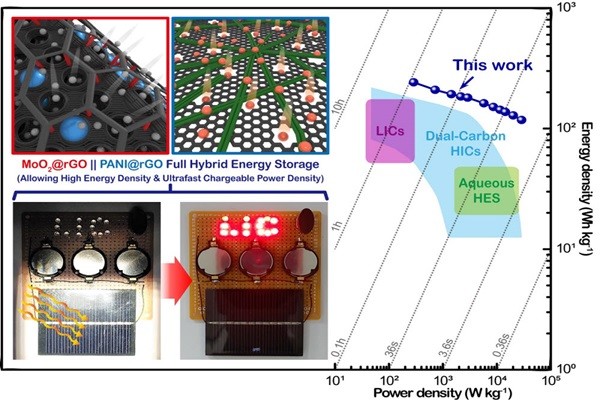The Korea Advanced Institute of Science and Technology (KAIST, President Shin Sung-chul) announced on Thursday that a research team led by Professor Kang Jeong-gu from the department of Materials Science and Engineering has developed a hybrid lithium-ion battery with high energy and high output.
The team has developed large-capacity anode material and cathode material based on a conductive carbon structure with a porous structure in which 2 to 50 nanometers mesopores and 2nm or less micropores exist at the same time.
The battery has energy density that is equivalent to that of commercialized lithium-ion batteries and characteristics of power density of a super capacitor. It can be used for rapid charging technology that requires minutes or seconds.
The team’s hybrid battery is drawing attention as a next-generation energy storage device as it has both high storage capacity of negative electrode and rapid ion charging and discharging of capacitor’s positive electrode. However, it is necessary to improve the negative electrode’s electrical conductivity and characteristics in storing ions, increase capacity of the positive electrode’s to store ions, and optimize two electrodes due to their different ion storing mechanisms.
The research team has solved the problem by developing cathode and anode materials based on conductive carbon using graphene oxide with a porous structure and large-capacity positive and negative electrodes with improved speed.

It has developed a carbon structure in which MoO2 (molybdenum metal oxide) that is 5 to 10 nanometers in size is bonded as a anode material. The structure is made up of micropores that facilitate penetration of lithium ions in electrolytes and graphene oxide shells that improve electrical conductivity.
The research team also used a new structural fabrication technology that cross links fiber-type conductive polymer on reduced graphene oxide. Through this technology, it has developed a cathode material for capacitors. Polyaniline (PANI), which is a conductive polymer, has a strong binding force and facilities adsorption of anion (PF6-).
The conductive PANI polymer-reduced graphene oxide anode has 200% more ion storage capacity than reduced graphene oxide. It also showed energy storage properties comparable to those of activated carbon.
“We have created an advanced lithium-ion battery that has energy density equivalent to that of lithium-ion batteries and enables rapid charging from high-power density.” said Professor Kang. “This product will increase quality peoples lives if its application is expanded towards every electronic device including electric vehicles.”
Staff Reporter Kim, Youngjoon | kyj85@etnews.com